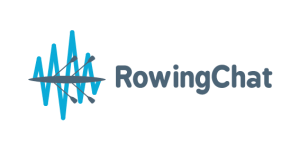Leg to back connection to make stroke power in rowing – Faster Masters Rowing Radio – the podcast for masters rowers. Tips, advice and discussion from Marlene Royle and Rebecca Caroe.
Support this show with a donation
https://fastermastersrowing.com/podcast
Timestamps
02:15 This Past Week – what we do to advocate for masters rowing. Rigging inaccuracies around the pins.
07:00 The Caught Short Kit for female athletes who menstruate – Help yourself to pads and tampons. Can you make one for your club?
10:00 Legs to Back Connection
The power of the legs has to be connected to the oar handle.
Leg drive must directly move the oar handle.
If you drive and don’t move the handle = shooting the slide.
If you move the handle and don’t move the legs = no power
Feel Pressure on your hands and feet – check for yourself.
Often described as the hardest part of the rowing stroke to train.
14:00 How does the kinetic chain link? This is how you are connected together. The biomechanics of how the body moves and flexes.
The levers of bones connect through the joints.
Ligaments connect bones to bones.
Tendons connect muscles to bones.
There are 2 types of kinetic chain in exercise sport
The open kinetic chain – where the limb is free and not fixed to an object
The closed kinetic chain – where the limb is connected to the ground or something firm
18:00 Rowing is a closed kinetic chain you are working off the oar handle, foot plate and the oar in the water.
Sponsor
www.onedayu.com/rowingchat
21:00 Training glutes – as you drive off the catch it’s the quads that activate first and as your heels go down you will add in your glutes.
Gluteal amnesia – it can be hard to activate the glutes as we age.
Strong glutes support your lower back.
23:40 Train your glutes by practicing isometrically. Squeeze them when standing, driving, sitting. To load your body weight in the boat you have got to use your glutes.
Be aware of them being strong and activated as you row.
27:00 Drills – keep pressure on the foot stretcher in the last third of the leg drive.
Glute bridges
Side squats
Fire Hydrants (this is funny…. check out the comments on the video at this point)
Hungarian split squats
Use exercise bands
Lunges
30:00 Timing the switch from legs to back in the power phase.
When the blade is loaded – notice if this varies.
Feel the blade is or is not stable in the water.
Handle pressure stays continuous and horizontal through the stroke.
If the body comes in too early you can lift the handle and the blade goes deep as a consequence.
Exaggeration exercises – try swinging the back early or later.
Make the back swing more dynamic
Arms and body only rowing to isolate the swing.
Check your force curve on the erg.
Back swing adds length to your stroke.
n
